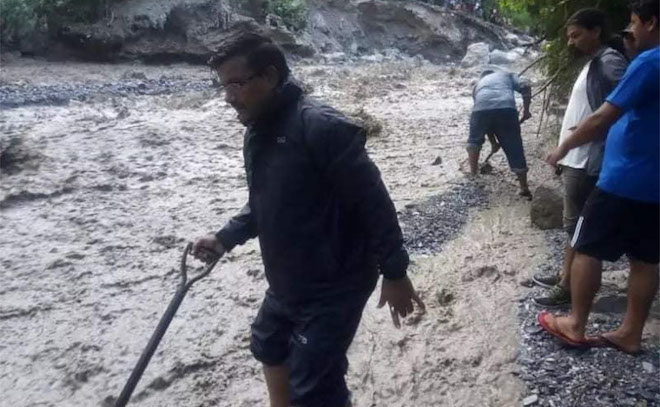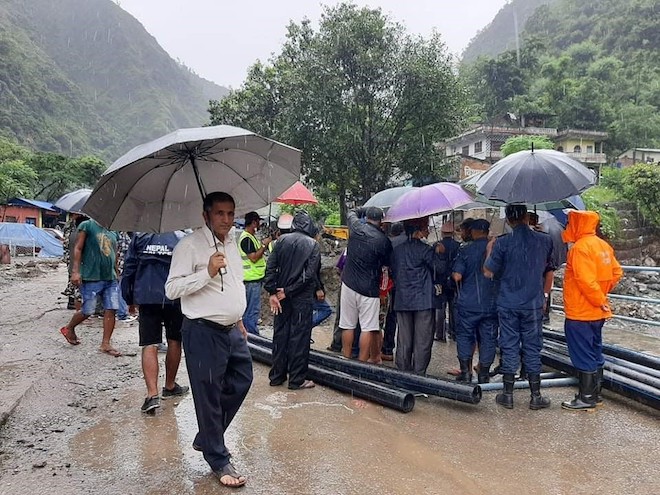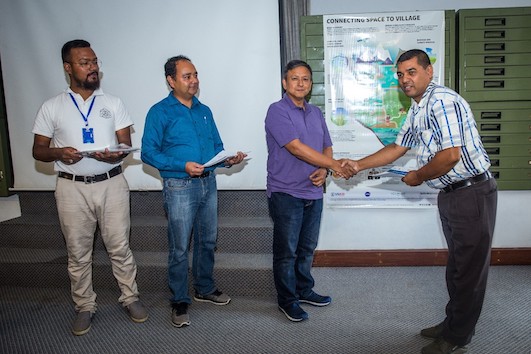A bearer of tidings: Teacher uses ICIMOD science application to help avert disaster in Dhading, Nepal

Written by Utsav Maden of SERVIR-HKH/ICIMOD. This article was originally featured on SERVIR-HKH's website. Click here to go to the original post.
Amid the deluge of reports on the tremendous loss and suffering caused by flooding each monsoon, there are some stories that inspire and gladden the heart. These are stories of perseverance and resourcefulness in the face of catastrophe that capture the imagination and spread hope. Keshab Prasad Kadel, a teacher and resident of Benighat Rorang Rural Municipality in Dhading, central Nepal, is the protagonist of one such story. During this year’s monsoon, Kadel was able to use a science application that we developed to predict flooding in a river stretch and relay this information to concerned authorities – saving property and possibly lives.

Ongoing remediation work in Dhading in the aftermath of the floods.
(Photo received courtesy of Parashu Ram Ghimire, Information Officer, Benighat Rural Municipality.)
The ever-present threat of floods
Each monsoon brings both joy and misery to Nepal. As agriculture is primarily rain-fed in Nepal, monsoon rain is a real godsend, nourishing farmlands and securing livelihoods for many farmers. However, the same monsoon rain – increasingly intense and erratic – also triggers different kinds of disasters. Turgid rivers sweep away lives and livelihoods and inundate large swathes of land, while accompanying landslides, rock falls, and mudslides cause massive destruction to infrastructure and obstruct major roadways in their wake. This year alone, these natural disasters – floods, landslides, and lightning strikes – have taken 158 lives, while 57 people have gone missing and 168 people were injured.
The situation is no different in Dhading, northwest of Kathmandu, where Kadel teaches management and is the Vice Principal at Shri Chandrodaya Secondary School in Benighat Rorang Rural Municipality, home to some 25,000 people. Almost every year, floods and landslides ravage his hometown, located at the foot of the Mahabharata range along the Trishuli River. These natural disasters repeatedly sweep away bridges and road sections, disrupting traffic along the landslide-prone Prithvi Highway, which runs through Dhading. The highway is an important conduit that connects Nepal’s capital to western districts.
Introduced to the power of geospatial information technology
Kadel acquainted himself with the HIWAT Streamflow Prediction Tool – a science application developed by our SERVIR Hindu Kush Himalaya (SERVIR-HKH) Initiative – at the connecting space to village training held at ICIMOD in 2019. The tool piqued his interest back then, as it predicted a flood with a 20-year return period for the Malekhu River bordering his hometown. As he travelled back home the same day, he was able to see the predictions come true as continuous rainfall fed and engorged river stretches. The following week, floods on the Malekhu River caused massive damage and devastated the under-construction Huaxin Cement Narayani factory located in Talti, resulting in losses worth millions. Floods swept away an excavator, two cars, and two tippers from the factory premises. Kadel recalls that this incident reinforced his confidence in the Tool’s prediction capabilities.

The High-Impact Weather Assessment Toolkit (HIWAT) Streamflow Prediction Tool for Nepal provides 48-hour flash flood forecasts
for 12,428 river segments in Nepal. The tool provides predicted estimates for flash floods from localized extreme weather phenomenon.
During this year’s monsoon, Kadel avidly used the prediction tool to keep track of potential flooding in small river stretches – Malekhu and Mauwa – that border his hometown.
Relaying critical flood information
On 19 July 2020, Kadel saw the Tool predict floods for the particular river stretch again. He took decisive action, immediately informing Tulashi Jung Thapa, local representative for the cement factory, and Hari Dallakoti, Chairperson of the rural municipality.
Incessant rainfall caused floods in river stretches and swept away Mauwa Khola bridge on 20 July, disrupting traffic for a week along the Prithvi Highway. Landslides and debris at multiple locations along the highway also obstructed traffic. The cement factory avoided damage from the floods, as its employees took heed of Kadel’s warning and used excavators to take flood prevention measures.
Tulashi Jung Thapa described their efforts, “After hearing from Keshab Kadel, we took preventive measures by digging and deepening the river channel. We wanted to avoid last year’s disaster. We kept excavators and tippers on standby and are on constant vigil.” Thapa adds that the factory has been constantly using the HIWAT Streamflow Prediction Tool, which has proven to be especially useful. He recommends that the Tool be shared for use across a wider audience.
Hari Dallakoti was on constant vigil and in communication with Kadel about any additional flood forecasts, as he worked with the Nepali Army, Nepal Police, and locals to mitigate the damage caused by the floods and landslides.

Hari Dallakoti in the field inspecting remediation work following the floods on Mauwa Khola bridge.

Nepali Army, Nepal Police, and locals inspect the diversion work at Mauwa Khola after the flood hit the Mauwa bridge on 20 July 2020.
Field photos received courtesy of Parashu Ram Ghimire, Information Officer, Benighat Rural Municipality.
In the aftermath, the cement factory and the ward chairman commended Kadel and praised him for the forewarning. Kadel shares that he is elated to have received such recognition and commendation from peers. He has also shared his knowledge on using the HIWAT Streamflow Prediction Tool with his peers and community members. He recommends that one needs to also assimilate other ancillary information – national weather and flood forecasts and local rainfall patterns – to complement readings of the Tool’s forecasts. He adds that teachers in a community setting are best suited to further the benefits of such science applications in rural areas.
About the Tool
The HIWAT Streamflow Prediction Tool for Nepal is the product of a collaborative effort among ICIMOD, Brigham Young University, and NASA’s Marshall Space Flight Center. To further this work, Nepal’s Department of Hydrology and Meteorology provided data on station locations with names and is working with us to validate forecasts using observational data from selected stations. We have also customized the Tool for Bangladesh and Bhutan and are working with national hydrological and meteorological services in the countries to validate forecasts from the Tool. The Tool is especially useful in areas where installation of instrument-based flood monitoring is not feasible.

Keshab Prasad Kadel accepting a certificate of participation at the closing ceremony of the
"Connecting space to village: Training teachers to disseminate EO & GIT knowledge" organized at ICIMOD
headquarters in Kathmandu, Nepal, from 12 to 15 July 2019. (Photo: Jitendra Raj Bajracharya/ICIMOD)
We organized the pilot training (which Kadel attended) on connecting space to village in 2019 in partnership with the Robotics Association of Nepal (RAN), training school teachers as change agents, fostering the use of Earth observation information and geospatial information technology. RAN worked with selected teachers to develop proposals around a minimum viable project to showcase lessons from the training in their schools and communities back home. During the COVID-19 pandemic this year, we partnered with RAN to organize a three-day virtual refresher training for school teachers. Some of these participants also organized community interactions to further the benefits of our science applications in their communities during the pandemic.

